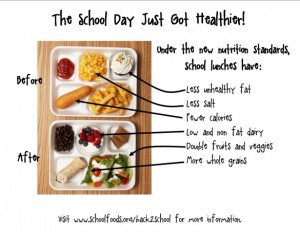Recently, I watched a documentary entitled Hungry for Change. This film condemns commercially produced foods, and features journalist Michael Pollan who warns us of the effects of consuming what he refers to as “food-like products.” Although the film mainly reiterates the importance of diet and physical health, it briefly touches upon the association between nutrient intake and cognition. According to Ralph DiLeone- Associate Professor of Psychiatry and Neurobiology at Yale University- “What we eat really affects our brain, our behavior, our neural circuits, and our health in many ways.” The National Institutes of Health more specifically demonstrates the correlation between nutritional intake and learning:
“The ingestion of nutrients triggers the release of hormones or peptides, such as insulin and glucagon-like peptide 1, into the circulation; these substances can then reach centers such as the hypothalamus and the hippocampus and activate signal-transduction pathways that promote synaptic activity and contribute to learning and memory.”
Why is this important?
While the correlation between nutrition and learning is known, many American schools- institutions designed for learning- are failing to provide children with healthy meal programs that support their education despite school nutrition standards (mentioned below). This makes no sense. If the aim of education is to learn and if the educational value of nutritious foods has been established, why do so many schools fail to instill healthier foods into their meal programs?
School Nutrition Laws and Policies:
Healthy Hunger-Free Kids Act (2010): Federal Statute signed into law by  President Barack Obama, with the focal point on improving child nutrition within the school systems.
President Barack Obama, with the focal point on improving child nutrition within the school systems.
Local School Wellness Policy (2004): Document that guides local education Agency or school district’s efforts to establish a school environment that promotes students’ health, well-being, and ability to learn by supporting healthy eating and physical activity.
What’s the Problem?
Despite being signed into law, there is much debate surrounding the implementation of the Healthy Hunger-Free Kids Act. While it promotes improved nutrition nationally, funding is an issue. Schools are reimbursed $3.01 per healthy lunch. However, schools only receive this reimbursement if they follow certain health rules: more fruits and vegetables, more whole grains and less sodium. While this may seem like a step in the right direction, that $3.01 per meal is also expected to cover labor, kitchen equipment and repairs. This makes it unsustainable for schools, particularly in lower income areas. In May 2014 a bill was passed that included a waiver to opt out of meeting USDA standards in schools with proven financial hardship.
Why should you care?
There is a disparity that is occurring. Schools in low income areas are among the most poorly funded; this makes it almost impossible to follow the rules that would allow them to receive reimbursement on meals. Without reimbursement on meals, it highly unlikely students will receive nutrient intake adequate enough to support cognitive functioning and learning. These are students who more than likely depend on school meals as main source of food, students who already have health deficiencies that may affect learning. If more people recognized the importance of nutrition on learning they would realize that we are in fact leaving children behind, by stunting their educational growth. Nutrient intake is just as, if not more, important than pencils, textbooks etc. It is our job, as humans, to recognize this and advocate for the vulnerable populations that may not be as familiar with their rights.
Who is in Charge?
-US Department of Agriculture: responsible for administering all school food service
-Congress (funding):
House: Subcommittee on Early Childhood, Elementary and Secondary Education
Senate: Subcommittee on Nutrition, Specialty Crops, Food and Agricultural Research